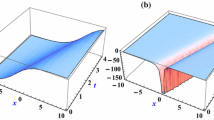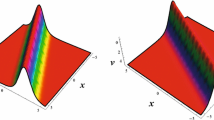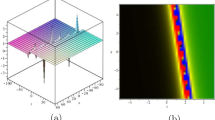Abstract
In this work, we present a new two-waves’ version of the fifth-order Korteweg–de Vries model. This model describes the propagation of moving two-waves under the influence of dispersion, nonlinearity, and phase velocity factors. We seek possible stationary wave solutions to this new model by means of Kudryashov-expansion method and sine–cosine function method. Also, we provide a graphical analysis to show the effect of phase velocity on the motion of the obtained solutions.
Similar content being viewed by others
1 Introduction
Stationary wave solutions for nonlinear equations play an important role in understanding many mathematical models arising in physics and applied sciences. These solutions were developed and categorized to fit many physical learned aspects (see [1]). For example, the authors of [2,3,4] used rogue soliton-waves to study the coupled variable-coefficient fourth-order nonlinear Schrödinger equations in an inhomogeneous optical fiber and coupled Sasa–Satsuma equations. Hu et al. in [5] explored the mixed lump–kink and rogue wave–kink solutions for a \((3+1)\)-dimensional B-type Kadomtsev–Petviashvili equation in fluid mechanics. Further, many interesting soliton-type solutions for physical applications that arise in plasma, surface waves of finite depth, and optical fiber were studied by researchers in, e.g., [6,7,8,9].
In this work, we present a new interesting two-wave version of the generalized fifth-order KdV equation which was discussed in [10, 11]. The standard fifth-order KdV equation has the form
where \(w=w(x,t)\) and \(a_{1}\), \(a_{2}\), \(a_{3}\) are some arbitrary constants. The fifth-order KdV equation (1.1) is a hybrid mathematical model with wide applications to surface and internal waves in fluids [11], as well as to waves in other media [12,13,14]. Special cases of (1.1) are widely used in different branches of sciences such as fluid physics, plasma physics, and quantum theory. For instance, when \(a_{1}=\frac{3}{10} a_{3}^{2}\), \(a_{2}=2 a _{3}\), \(a_{3}=10\), equation (1.1), called Lax equation, was studied in [15]. Also, when \(a_{1}=\frac{2}{5} a_{3}^{2}\), \(a_{2}=a _{3}\), \(a_{3}=5\), this equation is called Sawada–Kotera equation and was solved in [16]. In addition, the authors of [17] obtained the solution to (1.1) for \(a_{1}= \frac{1}{5}a_{3}^{2}\), \(a_{2}=a_{3}\), \(a_{3}=10\), which is known as the Kaup–Kupershmidt equation. Later on, under the assumption \(a_{1}=\frac{2}{9}a_{3}^{2}\), \(a_{2}=2a_{3}\), \(a_{3}=3\), the Ito equation was investigated in [18]. For the case \(a_{1}=45\), \(a_{2}=- \frac{75}{2}\), \(a_{3}=-15\), it is called Kaup–Kupershmidt–Parker–Dye equation [19]. The solution to Caudrey–Dodd–Gibbon equation was found in [20] provided that \(a_{1}=180\), \(a_{2}=30\), \(a _{3}=30\). Finally, for \(a_{1}=45\), \(a_{2}=-15\), \(a_{3}=-15\), (1.1) is called Sawada–Kotera–Parker–Dye equation, which was explored in [21].
The purpose of listing the aforementioned classifications of (1.1) is to highlight the importance and merit of studying new versions of the model, and also to explore its physical features. Now, we proceed to present for the first time the two-waves’ version of (1.1) by applying the operators
respectively, on the expressions \(a_{1} w^{2} w_{x}+a_{2} w_{x} w_{xx}+a _{3} w w_{xxx}\) and \(w_{xxxxx}\) and extending the term \(w_{t}\) into the expression \(w_{tt}-s^{2} w_{xx}\). Therefore, the two-wave fifth-order KdV (TWfKdV) is
where α, β, and s are the nonlinearity, dispersion, and phase velocity, respectively, with \(|\alpha | \leq 1\), \(|\beta | \leq 1\), and \(s \geq 0\). If we set \(s=0\) in (1.3) and integrate once with respect to time t, the TWfKdV equation is reduced to the fifth-order KdV equation (1.2) for the description of a single-wave propagating in one direction only. To learn about constructing two-mode equations, the reader is advised to read [22,23,24,25,26,27,28,29,30,31].
The two-wave equation (1.3) describes the spread of moving two-waves under the influence of dispersion, nonlinearity, and phase velocity factors. We aim to seek possible solutions for (1.3) by implementing two techniques, the Kudryashov-expansion method and sine–cosine function method. Also, we study the effect of phase velocity on the motion of the obtained solutions. Both techniques require converting (1.3) by means of the new variable \(\zeta =x-c t\) into the differential equation
where \(w=w(\zeta )\).
2 Kudryashov solutions of TMfKdV
The Kudryashov-expansion technique [32,33,34,35] proposes the solution of (1.4) as a polynomial of the variable Z, namely
where variable Z satisfies the differential equation
Solving (2.2) gives
where d is a nonzero free constant. The index n is to be determined by applying the order-balance procedure of the linear term \(w^{(5)}\) against the nonlinear term \(w^{2} w'\), which gives that \(n=2\). Therefore, we can write (2.1) as
Differentiating both (2.2) and (2.4) implicitly leads to
and
Now, we insert (2.2) through (2.6) into (1.4) to get a finite polynomial in Z. By setting each coefficient of \(Z^{i}\) to zero, a nonlinear algebraic system with unknowns \(A_{0}\), \(A_{1}\), \(A _{2}\), μ, c is obtained. We cannot solve the resulting system unless we consider some restrictions on the coefficients \(a_{0}\), \(a _{1}\), \(a_{2}\) and the parameters α, β.
2.1 Kudryashov-Case I
The first solution for the TMfKdV (1.3) exists when the coefficients are assigned as
and the two-mode parameters have the relation
Hence,
Therefore, the first obtained solution is
Figure 1 presents 3D plots of the two-waves depicted in (2.8) upon increasing the phase velocity s. Figure 2 is a 2D plot of (2.8) when coordinate x is fixed. It can be seen that these two waves can be regarded as left–right waves (having opposite directions).
Shapes of the two-waves depicted in (2.8) by increasing the phase velocity: \(s=1, 3, 5\), respectively, and the other assigned values are \(\beta =0.1\), \(d= \mu =A_{1}=1\)
2D plot of (2.8) when \(x=1\), \(s=5\) and the other assigned values are \(\beta =0.1\), \(d= \mu =A_{1}=1\)
2.2 Kudryashov-Case II
When we take the coefficients
and the two-wave parameters satisfy \(\alpha =\beta \), then the second solution for (1.3) is reached. Accordingly,
Thus, the second obtained solution is
Figure 3 presents the 3D plot of the two-waves depicted in (2.10).
The two-waves depicted in (2.10) with \(\beta =0.1\), \(s=d= \mu =A_{0}=1\)
2.3 Kudryashov-Case III
It is worth mentioning that when the two-waves’ parameters satisfy \(\alpha =\beta =\pm 1\), the third solution for TWfKdV (1.3) (with no restrictions on the coefficients \(a_{1}\), \(a_{2}\), \(a_{3}\)) is obtained. So,
which gives that the third obtained solution is
Figure 4 presents 3D plots of the two-waves depicted in (2.12) upon increasing the interaction phase velocity s.
Shapes of the two-waves depicted in (2.12) by increasing the phase velocity: \(s=5, 10, 15\), respectively, and the other assigned values are \(d= \mu =A_{0}=A_{1}=1\)
3 Sine–cosine solution of TMfKdV
The goal of this section is to find periodic solutions of TWfKdV by means of sine–cosine function method (see [36,37,38]). This scheme propose the solution of (1.4) in the form
or
To determine the values of A, p, μ and c, we substitute (3.1) or (3.2) in (1.4), and then collect the coefficients of same powers of \(\sin ^{i}\) or \(\cos ^{i}\) and set each to zero. In fact, we have an algebraic system with \(\alpha =\beta \), namely
Solving (3.3) requires \(p=-2\), and the TWfKdV’s coefficients are
So, we deduce that the wave speed c is
Therefore, two periodic-type solutions are
Figure 5 presents plots of the two-waves obtained in (3.6) upon increasing the phase velocity s.
Shapes of the two-waves depicted in (3.6) by increasing the phase velocity: \(s=1, 5, 10\), respectively, and the other assigned values are \(A=\mu =\beta =1\)
4 Conclusion
A new two-wave version of the generalized fifth-order KdV problem is established. This new model possesses two directional waves with interacting phase velocity. We obtained different solutions of this new model under particular choices of the coefficients \(a_{1}\), \(a_{2}\), \(a _{3}\), and the constraint condition \(\alpha =\beta =d\) with \(|d|<1\). Also, we studied the impact of increasing the phase velocity on the shape of spreading its two-waves. The following findings are recorded:
-
For \(a_{1}=\frac{6 \mu ^{2} a_{3}}{A_{1}}\), \(a_{2}=\frac{60 \mu ^{2}-A _{1} a_{3}}{A_{1}}\), \(a_{3}= \mathtt{free}\), and \(\alpha =\beta \), the TWfKdV is a soliton-type.
-
For \(a_{1}=\frac{(183- 7\sqrt{849}) \mu ^{4}}{8 A_{0}^{2}}\), \(a _{2}=\frac{(443- 7\sqrt{849}) \mu ^{2}}{8 A_{0}}\), \(a_{3}= \frac{-13 \mu ^{2}}{A_{0}}\), and \(\alpha =\beta \), the TWfKdV is a kink-type.
-
For arbitrary \(a_{1}\), \(a_{2}\), \(a_{3}\) and \(\alpha =\beta =\pm 1\), the TWfKdV is a kink-type.
-
For \(a_{1}=-\frac{6 a_{3} \mu ^{2}}{A}\), \(a_{2}=-\frac{A a_{3} +60 \mu ^{2}}{A}\) and \(\alpha =\beta \), the TWfKdV is a singular periodic-type.
We may say that these two-waves could be useful in many physical and engineering applications, for example, they can be used as barrier waves to strengthen the transmission of different signals’ data. Also, if a large amount of data is difficult to pass on to a single router, it can be distributed on two routers.
References
Gao, X.Y.: Mathematical view with observational/experimental consideration on certain \((2+1)\)-dimensional waves in the cosmic/laboratory dusty plasmas. Appl. Math. Lett. 91, 165–172 (2019)
Du, Z., Tian, B., Chai, H.P., Sun, Y., Zhao, X.H.: Rogue waves for the coupled variable-coefficient fourth-order nonlinear Schrödinger equations in an inhomogeneous optical fiber. Chaos Solitons Fractals 10(9), 90–98 (2018)
Liu, L., Tian, B., Yuan, Y.Q., Du, Z.: Dark–bright solitons and semirational rogue waves for the coupled Sasa–Satsuma equations. Phys. Rev. E 97, 052217 (2018)
Zhang, C.R., Tian, B., Wu, X.Y., Yuan, Y.Q., Du, X.X.: Rogue waves and solitons of the coherently-coupled nonlinear Schrödinger equations with the positive coherent coupling. Phys. Scr. 93, 095202 (2018)
Hu, C.C., Tian, B., Wu, X.Y., Yuan, Y.Q., Du, Z.: Mixed lump–kink and rogue wave–kink solutions for a \((3+1)\)-dimensional B-type Kadomtsev–Petviashvili equation in fluid mechanics. Eur. Phys. J. Plus 133, 40 (2018)
Zhao, X.H., Tian, B., Xie, X.Y., Wu, X.Y., Sun, Y., Guo, Y.J.: Solitons, Bäcklund transformation and Lax pair for a \((2+1)\)-dimensional Davey–Stewartson system on surface waves of finite depth. Waves Random Complex Media 28, 356–366 (2018)
Yuan, Y.Q., Tian, B., Liu, L., Wu, X.Y., Sun, Y.: Solitons for the \((2+1)\)-dimensional Konopelchenko–Dubrovsky equations. J. Math. Anal. Appl. 460, 476–486 (2018)
Du, X.X., Tian, B., Wu, X.Y., Yin, H.M., Zhang, C.R.: Lie group analysis, analytic solutions and conservation laws of the \((3+1)\)-dimensional Zakharov–Kuznetsov–Burgers equation in a collisionless magnetized electron–positron–ion plasma. Eur. Phys. J. Plus 133, 378 (2018)
Gao, X.Y.: Looking at a nonlinear inhomogeneous optical fiber through the generalized higher-order variable-coefficient Hirota equation. Appl. Math. Lett. 73, 143–149 (2017)
Bilige, S., Chaolu, T.: An extended simplest equation method and its application to several forms of the fifth-order KdV equation. Appl. Math. Comput. 216(11), 3146–3153 (2010)
Khusnutdinova, K.R., Stepanyants, Y.A., Tranter, M.R.: Soliton solutions to the fifth-order Korteweg–de Vries equation and their applications to surface and internal water waves. Phys. Fluids 30, 022104 (2018)
Grimshaw, R.H.J., Khusnutdinova, K.R., Moore, K.R.: Radiating solitary waves in coupled Boussinesq equations. IMA J. Appl. Math. 82(4), 802–820 (2017)
Khusnutdinova, K.R., Zhang, X.: Long ring waves in a stratified fluid over a shear flow. J. Fluid Mech. 794, 17–44 (2016)
Khusnutdinova, K.R., Zhang, X.: Nonlinear ring waves in a two-layer fluid. Physica D 333, 208–221 (2016)
Lax, P.D.: Integrals of nonlinear equations of evolution and solitary waves. Commun. Pure Appl. Math. 62, 467–490 (1968)
Sawada, K., Kotera, T.: A method for finding N-soliton solutions for the KdV equation and KdV-like equation. Prog. Theor. Phys. 51, 1355–1367 (1974)
Kaup, D.: On the inverse scattering problem for the cubic eigenvalue problems of the class \(\psi _{3x} + 6Q\psi _{x} + 6R_{\psi } = \lambda \psi \). Stud. Appl. Math. 62, 189–216 (1980)
Ito, M.: An extension of nonlinear evolution equations of the KdV (mKdV) type to higher orders. J. Phys. Soc. Jpn. 49, 771–778 (1980)
Kupershmidt, B.A.: A super KdV equation: an integrable system. Phys. Lett. A 102, 213–215 (1984)
Aiyer, R.N., Fuchssteiner, B., Oevel, W.: Solitons and discrete eigenfunctions of the recursion operator of non-linear evolution equations: the Caudrey–Dodd–Gibbon–Sawada–Kotera equations. J. Phys. A, Math. Gen. 19, 3755–3770 (1986)
Parker, A., Dye, J.M.: Boussinesq-type equations and switching solitons. Proc. Inst. NAS Ukr. 43(1), 344–351 (2002)
Korsunsky, S.V.: Soliton solutions for a second-order KdV equation. Phys. Lett. A 185, 174–176 (1994)
Wazwaz, A.M.: Two-mode Sharma–Tasso–Olver equation and two-mode fourth-order Burgers equation: multiple kink solutions. Alex. Eng. J. (2017). https://doi.org/10.1016/j.aej.2017.04.003
Alquran, M., Jarrah, A.: Jacobi elliptic function solutions for a two-mode KdV equation. J. King Saud Univ., Sci. (2017). https://doi.org/10.1016/j.jksus.2017.06.010
Syam, M., Jaradat, H.M., Alquran, M.: A study on the two-mode coupled modified Korteweg–de Vries using the simplified bilinear and the trigonometric-function methods. Nonlinear Dyn. 90(2), 1363–1371 (2017)
Jaradat, H.M., Syam, M., Alquran, M.: A two-mode coupled Korteweg–de Vries: multiple-soliton solutions and other exact solutions. Nonlinear Dyn. 90(1), 371–377 (2017)
Alquran, M., Jaradat, H.M., Syam, M.: A modified approach for a reliable study of new nonlinear equation: two-mode Korteweg–de Vries–Burgers equation. Nonlinear Dyn. 91(3), 1619–1626 (2018)
Jaradat, I., Alquran, M., Ali, M.: A numerical study on weak-dissipative two-mode perturbed Burgers’ and Ostrovsky models: right-left moving waves. Eur. Phys. J. Plus 133, 164 (2018)
Jaradat, I., Alquran, M., Momani, S., Biswas, A.: Dark and singular optical solutions with dual-mode nonlinear Schrodinger’s equation and Kerr-law nonlinearity. Optik 172, 822–825 (2018)
Wazwaz, A.M.: Multiple soliton solutions and other exact solutions for a two-mode KdV equation. Math. Methods Appl. Sci. 40(6), 1277–1283 (2017)
Hong, W.P., Jung, Y.D.: New non-traveling solitary wave solutions for a second-order Korteweg–de Vries equation. Z. Naturforsch. 54a, 375–378 (1999)
Alquran, M., Jaradat, I., Baleanu, D.: Shapes and dynamics of dual-mode Hirota–Satsuma coupled KdV equations: exact traveling wave solutions and analysis. Chin. J. Phys. 58, 49–56 (2019)
Abu Irwaq, I., Alquran, M., Jaradat, I.: New dual-mode Kadomtsev–Petviashvili model with strong–weak surface tension: analysis and application. Adv. Differ. Equ. 2018, 433 (2018)
Alquran, M., Jaradat, I.: Multiplicative of dual-waves generated upon increasing the phase velocity parameter embedded in dual-mode Schrödinger with nonlinearity Kerr laws. Nonlinear Dyn. 96(1), 115–121 (2019)
Kudryashov, N.A.: One method for finding exact solutions of nonlinear differential equations. Commun. Nonlinear Sci. Numer. Simul. 17(6), 2248–2253 (2012)
Alquran, M., Al-Khaled, K.: The tanh and sine–cosine methods for higher order equations of Korteweg–de Vries type. Phys. Scr. 84, 025010 (2011)
Alquran, M.: Solitons and periodic solutions to nonlinear partial differential equations by the sine–cosine method. Appl. Math. Inf. Sci. 6(1), 85–88 (2012)
Alquran, M., Qawasmeh, A.: Classifications of solutions to some generalized nonlinear evolution equations and systems by the sine–cosine method. Nonlinear Stud. 20(2), 261–270 (2013)
Acknowledgements
The authors would like to thank the editor and the anonymous referees for their in-depth reading and insightful comments on an earlier version of this paper.
Availability of data and materials
Not applicable.
Funding
Not applicable.
Author information
Authors and Affiliations
Contributions
All authors contributed equally and read and approved the final version of the manuscript.
Corresponding author
Ethics declarations
Ethics approval and consent to participate
Not applicable.
Competing interests
The authors declare that there is no conflict of interest regarding the publication of this manuscript. The authors declare that they have no competing interests.
Consent for publication
Not applicable.
Additional information
Publisher’s Note
Springer Nature remains neutral with regard to jurisdictional claims in published maps and institutional affiliations.
Rights and permissions
Open Access This article is distributed under the terms of the Creative Commons Attribution 4.0 International License (http://creativecommons.org/licenses/by/4.0/), which permits unrestricted use, distribution, and reproduction in any medium, provided you give appropriate credit to the original author(s) and the source, provide a link to the Creative Commons license, and indicate if changes were made.
About this article
Cite this article
Ali, M., Alquran, M., Jaradat, I. et al. Stationary wave solutions for new developed two-waves’ fifth-order Korteweg–de Vries equation. Adv Differ Equ 2019, 263 (2019). https://doi.org/10.1186/s13662-019-2157-6
Received:
Accepted:
Published:
DOI: https://doi.org/10.1186/s13662-019-2157-6









